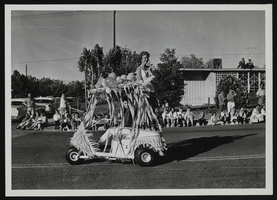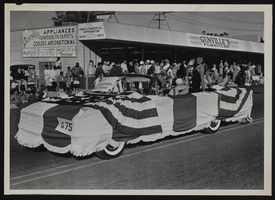Search the Special Collections and Archives Portal
Search Results

Transcript of interview with Carey Burke by Terri Goodsell, March 12, 1981
Date
Description
Text

Floats in the Henderson Industrial Days Parade: photographic print
Description

Floats in the Henderson Industrial Days Parade: photographic print
Description

James L. Hogan interview, October 12, 1975: transcript
Date
Archival Collection
Description
From the Ralph Roske Oral History Project on Early Las Vegas collection OH-00871. On October 12, 1975, collector Mary B. Hogan interviewed her father, farmer James L. Hogan (born April 6th, 1909 in Winton Place, Ohio) at the Hogan family home, in Las Vegas, Nevada. The interview covers the life of a Las Vegas old-timer. Mr. Hogan discusses moving to Las Vegas, early Las Vegas, Boulder Dam, and the Stewart Ranch. Colonel T. W. Miller and Vic Whittlesea are also mentioned.
Text

Interview with Robert Campbell, March 9, 2004
Date
Archival Collection
Description
Text
C. D. Williams oral history interview
Identifier
Abstract
Oral history interview with C. D. Williams conducted by Edwin R. Smith on July 07, 1975 for the Ralph Roske Oral History Project on Early Las Vegas. In this interview, Williams discusses his career as a firefighter in Las Vegas, Nevada and the history of the Las Vegas Fire & Rescue Department. He describes his early history, moving to Las Vegas in 1942, and how he obtained his position in the Las Vegas Fire & Rescue Department. Williams also describes his training, the equipment they utilized, and how that equipment, as well as the fire department itself, has changed over time. He tells anecdotes of calls and his experiences in the department. Williams explains how the construction of the Basic Magnesium Plant and Nellis Air Force Base affected the fire department. He talks about how and why the Clark County Fire Department and North Las Vegas Fire Department were established, and how Las Vegas casinos paid the city for fire protection. Lastly, Williams discusses being drafted during World War II and his service as a military fire fighter.
Archival Collection
J. A. Tiberti oral history interviews
Identifier
Abstract
Oral history interviews with J. A. Tiberti conducted by Claytee D. White on August 17, 2000 and August 24, 2000 for the Boyer Early Las Vegas Oral History Project. Tiberti begins by discussing his family history and his upbringing in the mining town of Morley, Colorado, and later in Detroit, Michigan. He describes moving to Las Vegas, Nevada in 1941, where he worked for the United States Corps of Engineers on the construction of Nellis Air Force Base and later established his construction company, J. A. Tiberti Construction Company. Tiberti talks about being a member of the City of Las Vegas Planning Commission, the duties and responsibilities that came with being on the Planning Commission, and describes how a construction company is run. He also discusses his wife, children, and how Las Vegas has changed and grown since the 1940s.
Archival Collection

Relda W. Leavitt interview, March 18, 1976: transcript
Date
Archival Collection
Description
On March 18, 1976, collector David Steele Broussard interviewed Relda Whitney Leavitt (born April 3rd, 1917 in Saint Thomas, Nevada) at her home in Las Vegas, Nevada. In this interview, Mrs. Leavitt discusses growing up in Saint Thomas, Nevada before her family moved to Las Vegas. She also discusses moving to Las Vegas, Nevada and her family’s dairy business in Whitney, Nevada. She speaks about the different changes and growth she has seen in Las Vegas over the years.
Text

Jack K. Leavitt interview, February 28, 1979: transcript
Date
Archival Collection
Description
On February 28, 1979, collector Alick Dziabczenko interviewed Jack Leavitt in Las Vegas, Nevada. In this interview Mr. Leavitt talks about his childhood in Las Vegas. He also talks about his family life and his career in the city, as well as some of the many changes he has seen in Las Vegas.
Text

Aracely Rascon oral history interview: transcript
Date
Archival Collection
Description
Oral history interview with Aracely Rascon conducted by Claytee D. White on October 2, 2018 for the Remembering 1 October Oral History Project. In this interview, Rascon recalls her early childhood in Chihuahua, Mexico and until her father brought the family to Las Vegas, Nevada. She studied interior design at the University of Nevada, Las Vegas (UNLV) and joined the firm of Simpson Coulter, where she specializes in decorating the interiors of businesses and schools. Two weeks after the October 1, 2017 shooting, her skills were called upon by those across the city who were preparing the Resiliency Center for survivors of the mass shooting. This proposed Resiliency Center needed carpet, paint, furniture, art work, and everything else to make it into a place where people could seek assistance in a peaceful atmosphere where they could tell their stories and ask for help. Rascon contacted all her resources and was pleasantly surprised when each company bent over backwards to offer deals, advice, and referrals. Rascon learned that she could use her talents and decorating skills to help others be at peace and to dialogue and perform in comfort. She will never forget and will be forever grateful to the sense of community displayed by her city.
Text
